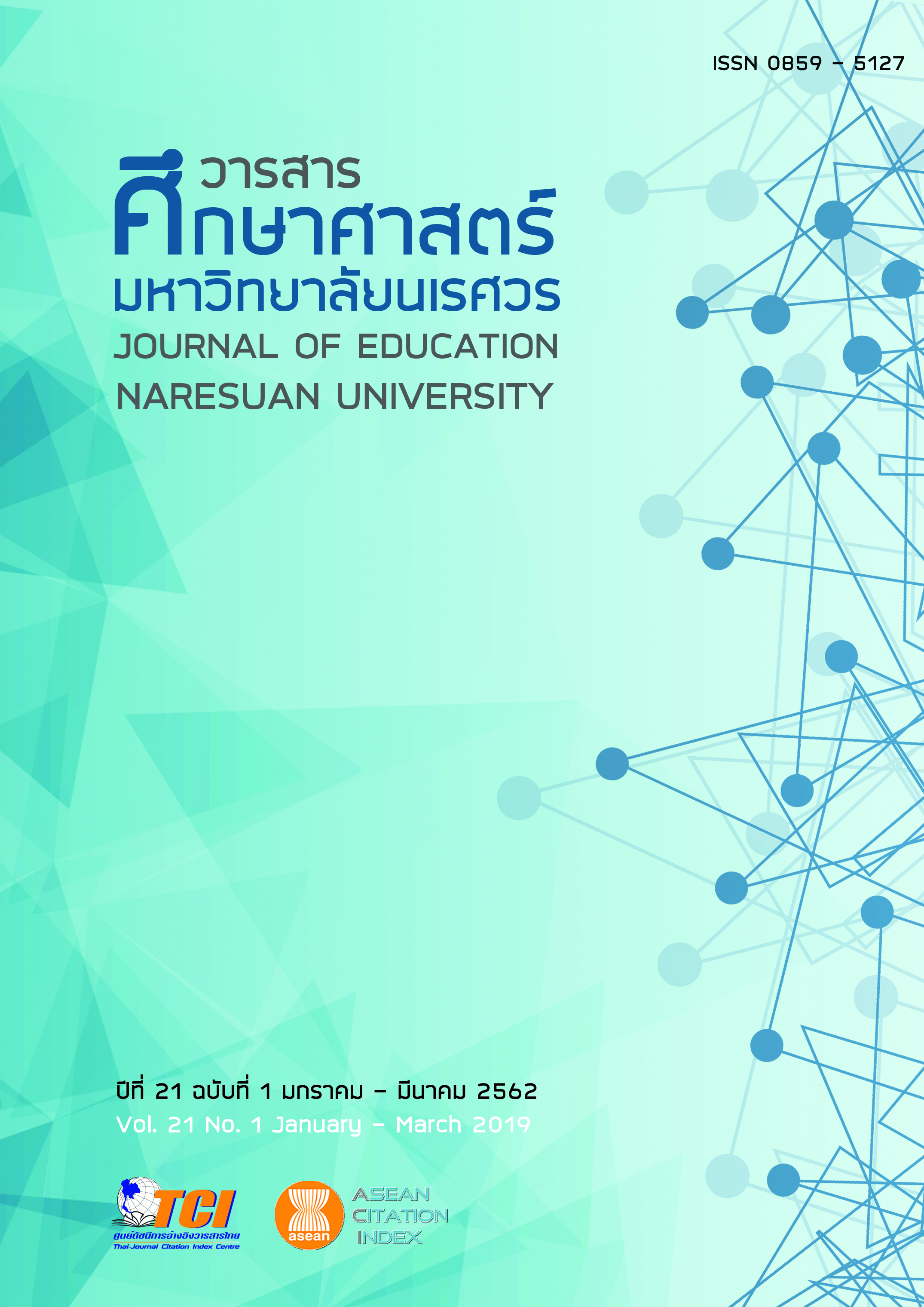รูปแบบภาคีเครือข่ายความร่วมมือเพื่อเสริมสร้างสมรรถนะการอ่านของนักเรียนระดับประถมศึกษาในจังหวัดสุโขทัย (A MODEL OF COLLABORATIVE NETWORKS FOR FOSTERING READING COMPETENCY OF PRIMARY STUDENT SUKHOTHAI PROVINCE)
Main Article Content
Abstract
การวิจัยครั้งนี้มีวัตถุประสงค์เพื่อพัฒนารูปแบบภาคีเครือข่ายความร่วมมือเพื่อเสริมสร้างสมรรถนะการอ่านของนักเรียนระดับประถมศึกษาในจังหวัดสุโขทัย มีขั้นตอนการวิจัย 4 ขั้นตอน คือ 1) ศึกษาตัวแบบเครือข่ายความร่วมมือเพื่อเสริมสร้างสมรรถนะการอ่านของนักเรียนระดับประถมศึกษาของสำนักงานเขตพื้นที่การศึกษาประถมศึกษาสุโขทัย เขต 2 ที่มีวิธีปฏิบัติที่ดี (Good Practice) โดยใช้วิธีการศึกษาเอกสารตัวแบบฯ และสังเคราะห์เอกสาร 2) สร้างรูปแบบภาคีเครือข่ายความร่วมมือเพื่อเสริมสร้างสมรรถนะการอ่านของนักเรียนระดับประถมศึกษาในจังหวัดสุโขทัย โดยสังเคราะห์ข้อมูลจากการศึกษาขั้นที่ 1 เพื่อสร้างกรอบการสัมภาษณ์ผู้มีส่วนได้ส่วนเสียและผู้ทรงคุณวุฒิในจังหวัดสุโขทัย จำนวน 15 คน และสัมภาษณ์ผู้ทรงคุณวุฒิภายนอก จำนวน 9 คน 3) ทดลองขับเคลื่อนรูปแบบภาคีเครือข่ายความร่วมมือเพื่อเสริมสร้างสมรรถนะการอ่านของนักเรียนระดับประถมศึกษาในจังหวัดสุโขทัย โดยการแต่งตั้งกลไกภาคีเครือข่ายความร่วมมือ จำนวน 27 คน และประธานเครือข่ายสถานศึกษา จำนวน 32 คน และ 4) ประเมินผลการทดลองขับเคลื่อนรูปแบบภาคีเครือข่ายความร่วมมือเพื่อเสริมสร้างสมรรถนะการอ่านของนักเรียนระดับประถมศึกษาในจังหวัดสุโขทัย โดยจัดเวทีระดมความคิดเห็นของประธานเครือข่ายสถานศึกษา ตัวแทนผู้บริหารสถานศึกษาและตัวแทนครูผู้สอนภาษาไทย จำนวน 86 คน ผลการวิจัย พบว่า
1. รูปแบบภาคีเครือข่ายความร่วมมือเพื่อเสริมสร้างสมรรถนะการอ่านของนักเรียนระดับประถมศึกษาในจังหวัดสุโขทัย ประกอบไปด้วย 2 องค์ประกอบ 1 เงื่อนไขความสำเร็จ ได้แก่ องค์ประกอบที่ 1 กลไกภาคีเครือข่ายความร่วมมือ ประกอบด้วย กลไกขับเคลื่อนภาคีเครือข่ายจังหวัด กลไกขับเคลื่อนภาคีเครือข่ายสถานศึกษา และกลไกนิเทศ ติดตาม การขับเคลื่อนภาคีเครือข่ายความร่วมมือ มีการกำหนดโครงสร้าง และบทบาทหน้าที่ องค์ประกอบที่ 2 ระบบเสริมสร้างสมรรถนะการอ่านของนักเรียนระดับประถมศึกษา ประกอบไปด้วย 3 กระบวนการ คือ 1) กระบวนการทำงานของกลไกขับเคลื่อนภาคีเครือข่ายจังหวัด 2) กระบวนการทำงานของกลไกขับเคลื่อนภาคีเครือข่ายสถานศึกษา และ 3) กระบวนการทำงานของกลไกนิเทศ ติดตามการขับเคลื่อนภาคีเครือข่ายความร่วมมือ ใน 6 ขั้นตอน ได้แก่ การกำหนดเป้าหมายและจุดเน้น การจัดทำบัญชีคำพื้นฐาน การจัดองค์การและการจัดกิจกรรมการเรียนการสอน การวัดและประเมินผล การนิเทศ ติดตาม และการสร้างขวัญกำลังใจ เงื่อนไขความสำเร็จ ประกอบไปด้วย การสนับสนุนทรัพยากร สัมพันธภาพของบุคคลและหน่วยงานที่จัดการศึกษา ภาวะผู้นำของผู้บริหาร
2. ผลการทดลองขับเคลื่อนรูปแบบภาคีเครือข่ายความร่วมมือเพื่อเสริมสร้างสมรรถนะการอ่านของนักเรียนระดับประถมศึกษาในจังหวัดสุโขทัย พบว่า กลไกทั้ง 3 กลไก มีการดำเนินการขับเคลื่อนระบบเสริมสร้างสมรรถนะการอ่านฯ เป็นไปตามปฏิทินการดำเนินงานที่กำหนดของแต่ละกลไกภาคีเครือข่ายความร่วมมือในภาพรวมมีความเหมาะสมอยู่ในระดับมาก
3. ผลการประเมินการทดลองขับเคลื่อนรูปแบบภาคีเครือข่ายความร่วมมือเพื่อเสริมสร้างสมรรถนะการอ่านของนักเรียนระดับประถมศึกษาในจังหวัดสุโขทัย พบว่า ด้านประสิทธิภาพในภาพรวมมีความเหมาะสมอยู่ในระดับมาก และด้านผลลัพธ์ พบว่า นักเรียนระดับประถมศึกษาทุกสังกัดในจังหวัดสุโขทัย มีสมรรถนะการอ่านสูงขึ้น
A MODEL OF COLLABORATIVE NETWORKS FOR FOSTERING READING COMPETENCY OF PRIMARY STUDENT SUKHOTHAI PROVINCE
This research aimed to develop a model of collaborative networks for fostering reading competency of primary students in Sukhothai province. The research procedure followed 4 steps; 1) studying the component of the collaborative networks for fostering reading competency of primary students in Sukhothai area office 2 which had good practice by using content analysis technique, 2) drafting the model of collaborative networks for fostering reading competency of primary students in Sukhothai province based on the data interviewed and discussed of 9 experts, 3) experimentation the model of collaborative networks for fostering reading competency of primary students in Sukhothai province by 32 principals who are the head of connective schools, and 4) assessing the drafted the model of collaborative networks for fostering reading competency of primary students in Sukhothai province by setting the stage for brain-storming and discussing
the opinions between 86 heads of connective school, representatives of schools’ directors and representatives of Thai teachers. The research findings were as followed:
1. A model of collaborative networks for fostering reading competency of primary students in Sukhothai province consisted of 2 components 1 conditions: 1) the mechanisms of collaborative networks for fostering reading competency including the province collaborative networks mechanisms, school collaborative networks mechanisms and school’s supervisor collaborative networks mechanisms. 2) The system for fostering reading competency for primary’ students including 6 main methods: 1) set up a goal and focus, 2) make term basis of words, 3) manage the organization and teaching activities, 4) measure and evaluate, 5) supervise, and 6) make the morale. Success conditions include: 1) resource support, 2) relationship of persons and entities, and 3) executive leadership.
2. The results experimentation of model consisted working process showed that mmechanism of the 3 network implemented according to the designated operating calendar of each partner network mechanism and result of assessing model found that all components of model were at a high level.
3. The result of assessing experimentation of a model of collaborative networks for fostering reading competency of primary students in Sukhothai province found that the effective was in high level and primary students in Sukhothai province got high reading competency.
Article Details
The owner of the article does not copy or violate any of its copyright. If any copyright infringement occurs or prosecution, in any case, the Editorial Board is not involved in all the rights to the owner of the article to be performed.
References
Arkomkong, S. (2007). A collaboration model of Tambon Administration Organization of basic education management in the Lower Northern Region of Thailand. Ramkhamhaeng research journal of humanities and social science, 10(2), 49-57. [in Thai]
Boonrugsa, C., Jansila, V., Mejang, S., & Wannasri, J. (2014). A cooperative management model for resource utilization on bachelor’s degree programs in vocational institutes. Journal of Education Naresuan University, 16(3), 147-159. [in Thai]
Buasai, S. (2011). ABC: Area-based collaborative research. Bangkok: Amarin Printing and Publishing. [in Thai]
Bureau of Information and Communication Technology. (2009). Thailand Cabinet started “Reading to be National Agenda”. Retrieved December 14, 2015, from bumrung@emisc.moc.go.th [in Thai]
Khumbunchoo, J. (2015). A research and development of area based management to reduce the differences of medium schools in Lampang Province. Lampang: The Thailand Research Fund. [in Thai]
Khwanmun, P., Chanbanchong, C., Pakdeewong, P., & Kornpuang, A. (2013). The development of the model for public service activity management in schools under the primary education service areas on Thailand – Myanmar border. Journal of Education Naresuan University, 15(special), 124-135. [in Thai]
Panich, W. (2012). The ways to build learning for students in 21st Century. Bangkok: Sodsri – Saritwong Foundation. [in Thai]
Samawimol, M. (2015). A research and development of area based management for fostering reading competency of Primary Student Sukhothai Province. Sukhothai: Thailand Research Fund. [in Thai]
Sitthongsi, B., Sungkawadee, P., Jansila, V., & Mejang, S. (2015). A model for administration of networking school cluster in primary educational service area office. Journal of Education Naresuan University, 17(4), 105-114. [in Thai]
Sukhothai Primary Educational Service Area Office 2. (2014). A model of collaborative network for developing reading competency of elementary students in Sukhothai primary educational service area office 2. Sukhothai: Sukhothai Primary Educational Service Area Office 2. [in Thai]
The Institute for the Promotion of Teaching Science and Technology. (2014). PISA Project in Thailand 2012. Bangkok: Seven Printing Group. [in Thai]
The Office of the Basic Education Commission. (2008). Announcement: Focus and guideline for developing reading of students. Bangkok: Office of the Basic Education Commission. [in Thai]
The Office of Basic Educational Commission. (2015). E-MES Report. Bangkok: The Office of Basic Educational Commission. [in Thai]
The Office of Educational Council. (2011). System to enhance the participation in students development. Bangkok: Prikwarn Graphic. [in Thai]
Tulsook, P. (2005). The development of model and operational efficiency of the schools in Thailand (Doctoral dissertation). Phitsanulok: Naresuan University. [in Thai]


